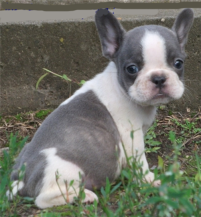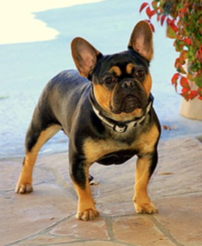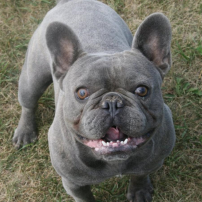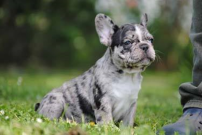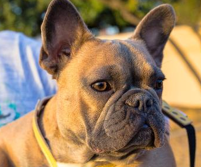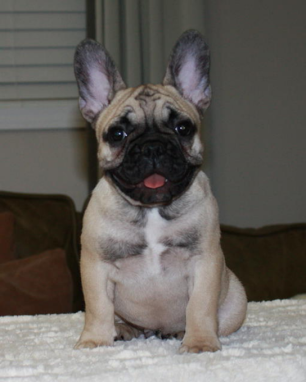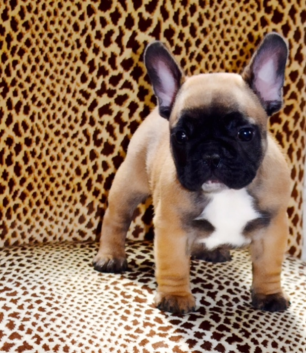French Bulldog Club of America: Standard revisions
submitted by Robin Stansell, JEC, French Bulldog Club of America
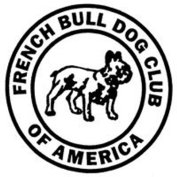 The French Bull Dog Club of America recently approved several changes to the breed standard. These changes were approved by the AKC Board of Directors at its April 2018 meeting and the new standard is effective June 5, 2018.
The French Bull Dog Club of America recently approved several changes to the breed standard. These changes were approved by the AKC Board of Directors at its April 2018 meeting and the new standard is effective June 5, 2018.
The standard added to the general appearance: “The hallmarks of the breed are the square head with bat ears and the roach back.” The disqualification for “Any alteration other than removal of dewclaws is considered mutilation and is a disqualification” was eliminated.
We are seeing an explosion of fad color breeders in the French Bulldog. Some of their offspring are appearing in the show ring. To ensure the exclusion of improperly colored dogs becoming champions, we changed the standard regarding color of eyes, nose, and coat.
Eyes were not defined by color – just “dark.” We clarified the standard to say that the eyes are dark brown or approaching black in color. We also clarified that lighter brown colored eyes are acceptable, but not desirable. Any other color is not acceptable. Blue or green eye(s) or any traces of blue or green are a disqualification. Many of the exotic coat colors also have blue or green eyes. If you are unable to positively identify an incorrect coat color, improperly colored eyes, may be the easiest way to eliminate the incorrectly colored dog.
Nose color is black. All others are to be disqualified with one exception. We have clarified which lighter colored dogs may have other than a black nose. The brindle pieds are not allowed a lighter nose. Only creams or fawns without black masks may have a lighter colored nose. This lighter color is acceptable but not desirable. Noses that must still be disqualified include blue or liver noses.
We are seeing increasing number of incorrect mouths. Wry has always been problematic in the breed. This standard clarifies that wry mouths are serious faults. The degree of the penalty would be commensurate with the degree of the wryness. Of even greater concern is lack of undershot jaws. An undershot jaw is one of the breed’s critical traits. We hope you will not reward a French Bulldog with an even or scissors bite. If you see a tongue hanging, please investigate the mouth closer. It could be an indication of an improper mouth. However, please use your common sense. It could also be the product of heat or stress.
The roach back is one of the hallmarks of the breed. The backline has a slight fall close behind the shoulders and then gradually rises to the loin which is higher than the shoulder. This should not be an abrupt rise. Some toplines have a more forward rise. This is incorrect. The rise must be over the loin. The previous standard did not describe the croup. This is an important finish to the topline. There must be some rounding to the croup. The topline is a flow of gentle curves.
The body description was changed to require a pear shape. We are seeing some “hourglass” bodies in the ring which are broad at the shoulder and the rear with a narrow waist. This is incorrect. The front should be broader with the rear narrower. The lines between the front and the rear should not be abrupt but a gradual taper still retaining the broad, deep and full chest with a slightly tucked-up belly.
The fad breeders are also experimenting with the coat texture. We have seen long-coated dogs advertised for sale. For that reason, we added a disqualification for coats “other than short and smooth.” Some judges have expressed concern over our range of coat texture from fine, moderately fine to a thicker and coarser smooth coat. Since we did not want to disqualify the range of coat texture we can find in our smooth coats, we eliminated “moderately fine.”

Our previous standard disqualified certain colors and patterns. The ingenuity of the fad breeders taught us that we can not list colors and patterns to DQ. They just come up with new ones we had not thought of before! So, we defined the colors, markings and patterns that are acceptable and disqualified everything else. The new standard reads:
“Acceptable Colors: white, cream, fawn (ranging from light fawn to a red fawn), or any combinations of the foregoing.
Markings and patterns are: brindle, piebald, black mask, black shadings, and white markings. Ticking is acceptable but not desired. Brindle ranges from sparse but clearly defined black stripes on a fawn background to such heavy concentration of black striping that the essential fawn background color barely shows through (“black brindle”). Only a trace of the background color is necessary; in a brindle piebald, a trace of the brindle patterning in any patch is sufficient.
Any other colors, markings or patterns are a disqualification. Disqualifying colors and patterns include, but are not limited to, solid black, black and tan, black and white, white and black, blue, blue fawn, liver, and merle. Black means black without a trace of brindle.”
Examples of dogs that must be DQed for color are in order of pictured: Liver, blue brindle, black and tan, blue, merle, and blue fawn.
Ticking is addressed for the first time. Since we are disqualifying all colors, patterns, and markings other than allowed, we needed to address ticking. We prefer a clear coat; however, ticking is acceptable. We have also added “black shadings.” This allowance does not allow a black dog, a black and white dog, or a white and black dog. What is does allow: black masks and some transitional shadings or smudging between acceptable colors, most notably fawn to white. It also allows some minimal black tipping. Acceptable black markings are featured here.
The new standard corrects the language used for movement. The French Bulldog should not double track. The proper gait does not have two parallel tracks on the right and left. The previous standard misused the term “double tracking.” The correct gait is now described as a “’four tracking’ foot pattern with the front track wider than the rear track.”
The complete list of disqualifications are:
- Over 28 pounds in weight.
- Blue or green eye(s) or any traces of blue or green.
- Other than bat ears.
- Nose other than black, except in the case of cream or fawn colored dogs without black masks, where a lighter colored nose is acceptable.
- Coats other than short and smooth.
- All coat colors other than those specifically described (e.g., solid black, mouse, liver, black and tan, black and white, and white with black, blue, blue fawn, liver, and merle). Black means black without a trace of brindle. All other patterns and markings other than specifically described.
If you have any questions about the changes, please contact the FBDCA Judges’ Education


